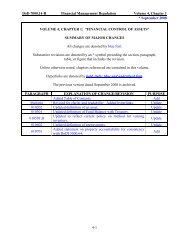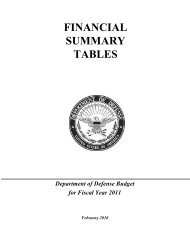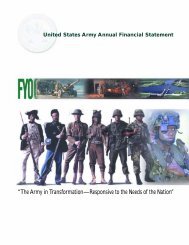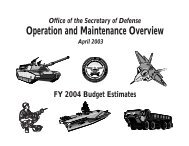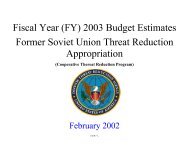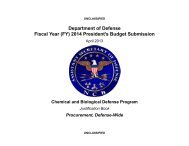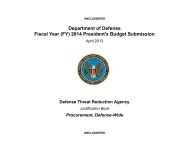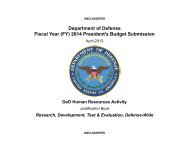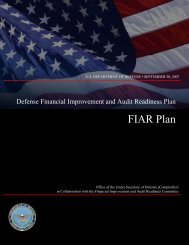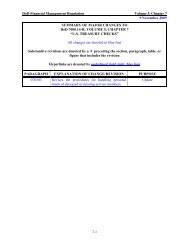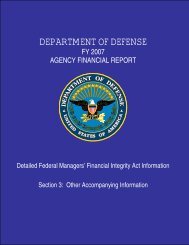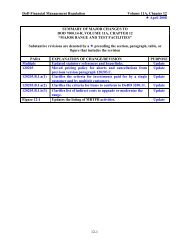Defense Information Systems Agency - Office of the Under Secretary ...
Defense Information Systems Agency - Office of the Under Secretary ...
Defense Information Systems Agency - Office of the Under Secretary ...
- No tags were found...
You also want an ePaper? Increase the reach of your titles
YUMPU automatically turns print PDFs into web optimized ePapers that Google loves.
UNCLASSIFIED<br />
Exhibit R-2, RDT&E Budget Item Justification Date: May 2009<br />
Appropriation/Budget Activity<br />
RDT&E, <strong>Defense</strong>-Wide/05<br />
R-1 Item Nomenclature<br />
Joint Command and Control Program (JC2)/PE 0303158K<br />
Cost ($ in millions) FY 2008 FY 2009 FY 2010 FY 2011 FY 2012 FY 2013 FY 2014 FY 2015<br />
Joint Command and Control Program (JC2)/JC01 56.461 56.618 49.047<br />
integration processes not yet available, such as interdependencies with NCES and <strong>the</strong> Military Services’<br />
infrastructures.<br />
Modeling and Simulation. The NECC Program recognizes <strong>the</strong> need to understand <strong>the</strong> scalability and performance <strong>of</strong> <strong>the</strong><br />
NECC architecture and deployed capabilities. Detailed modeling and simulation activities show scalability <strong>of</strong> <strong>the</strong> NECC<br />
architecture beyond <strong>the</strong> operationally relevant test environment to a much larger installation throughout <strong>the</strong> Global<br />
<strong>Information</strong> Grid. In FY 2009, <strong>the</strong> program uses data ga<strong>the</strong>red from prototyping activities to produce models which will<br />
simulate <strong>the</strong> operational environments using enterprise and Service infrastructures, network environments including<br />
disadvantaged communication conditions, <strong>the</strong> deployed component <strong>of</strong> capability modules, and two intended mission threads.<br />
These simulations will be used to run a series <strong>of</strong> scalability analyses designed to produce a stressing load while<br />
executing <strong>the</strong> simulated mission threads. Data from all simulation activities will be provided to <strong>the</strong> DUSD(S&T) and<br />
used to update <strong>the</strong> architecture, design, deployment strategies, and o<strong>the</strong>r relevant technical activities within NECC.<br />
Testing. Comprehensive testing culminates <strong>the</strong> FY 2009 activities. The NECC Program will conduct an End-to-End (E2E)<br />
Developmental Test (DT) which tests a set <strong>of</strong> capability modules within <strong>the</strong> context <strong>of</strong> <strong>the</strong> Joint Personnel Rescue (JPR)<br />
Mission Thread using <strong>the</strong> operational environment to <strong>the</strong> maximum extent possible. The Operational Tester community<br />
supports <strong>the</strong> E2E DT event. An Operation Test <strong>Agency</strong> (OTA) Milestone Assessment Report will be completed by <strong>the</strong> Lead<br />
OTA to inform Milestone B. Through <strong>the</strong> FY 2009 testing events, <strong>the</strong> program will demonstrate a mature and repeatable<br />
testing process that has been fully coordinated with DOT&E and directly responds to <strong>the</strong> testing concerns. The program<br />
is updating <strong>the</strong> Test and Evaluation Master Plan (TEMP) to fur<strong>the</strong>r define <strong>the</strong> details <strong>of</strong> this strategy, and DOT&E and<br />
DDRE are major stakeholders in <strong>the</strong> TEMP development process. The JST has overseen significant improvements to testing<br />
governance using <strong>the</strong> Test, Evaluation, and Certification Criteria and <strong>the</strong> FDCE. Process improvements have been made in<br />
<strong>the</strong> areas <strong>of</strong> test planning and test execution.<br />
In FY 2009, NECC will complete a Preliminary Design Review (PDR) as directed by <strong>the</strong> DAE and <strong>the</strong> DoD 5000.02, prior to a<br />
Milestone B decision to reduce risk and provide a better program baseline. The PDR establishes <strong>the</strong> allocated baseline<br />
and <strong>the</strong> underlying architecture to support a high-confidence design. The PDR describes requirement trade-<strong>of</strong>fs,<br />
improves <strong>the</strong> program <strong>of</strong>fice estimate, and identifies residual design, integration and development risks. The PDR will<br />
include participation from all key NECC stakeholders. The PDR report will be provided to <strong>the</strong> Milestone Decision<br />
Authority at Milestone B and include <strong>the</strong> recommended requirements trades based upon an assessment <strong>of</strong> cost, schedule,<br />
and performance risk.<br />
R-1 Line Item No. 124<br />
Page 5 <strong>of</strong> 17<br />
UNCLASSIFIED



